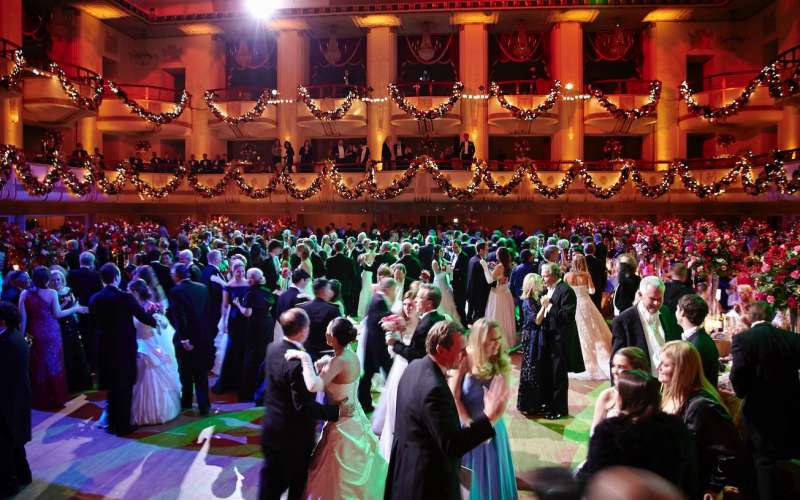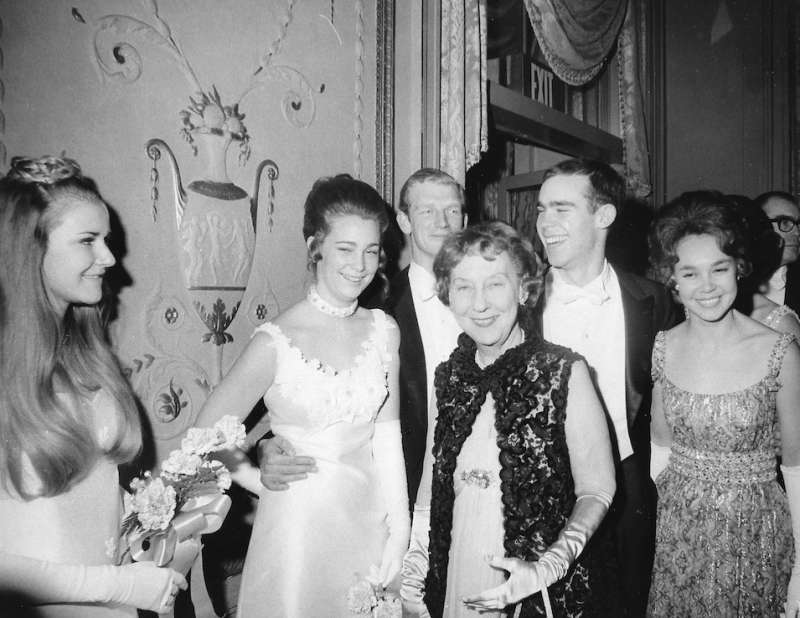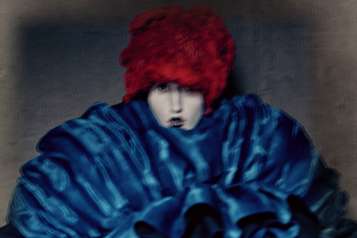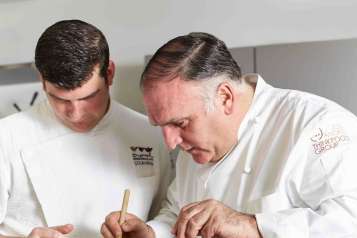
Photo Credit: International Debutante Ball
Why have so many descendants of American presidents taken their bows at the International Debutante Ball? Three generations of the Eisenhower family—Anne Eisenhower, her daughter Adriana Echavarria, and granddaughter Camila Mendoza, who will represent the United States at this year’s gala—talk about how they chose this glittery biannual fete for their debuts.
The International Debutante Ball made its entrance into New York society in 1954, and has attracted the daughters of the world’s titled, rich, and famous for more than 60 years. Despite it being rooted in New York, the white-tie gathering draws not only young women from every state but also from countries throughout Europe and, in recent times, Asia as well. Perhaps most notably throughout its six-decade history and the huge cultural shifts in American society that have taken place since its inception, the ball has remained the debutante event with the strongest (and bipartisan) ties to the White House. Eight descendants of President Eisenhower, two granddaughters of President Johnson, two daughters and a granddaughter of President Nixon, and one granddaughter of President Bush have all been belles at the ball.

Photo Credit: International Debutante Ball
As to why the IDB has been a magnet for presidential families, Margaret Hedberg, its general chairman since 1983 (the year she took over from her aunt, founder Beatrice Joyce), attributes the reason to several factors—the first being its international scope. “We were never the big local party,” says Hedberg, who can claim her own White House ties (she met her husband, Gregory, through Edward Cox, who married Tricia Nixon). “At the ball, each young woman has the chance to represent her country or state during the evening’s formal presentation. My aunt was thrilled when the Nixon daughters, and then the Eisenhower granddaughters, agreed to be debs for the United States. It was a great honor.”
Presidential offspring aside, the IDB has always attracted a lot of media attention for the prominent young women it showcases. In the 1960s, when Anne Eisenhower made her debut, the event was even televised live. For debs, living either directly or tangentially in the spotlight, knowing that they were in Joyce’s very good, white-gloved hands during one of the highest-profile moments in their young lives helped, too. Similarly, in an era drowning in social media shares, the fact that Hedberg (an IDB deb in 1963) has been running the show with flawless panache and media savvy for 33 years comes as relief to today’s debs and their parents, who pay $22,000 for the privilege of seeing their daughters come out at the ball.
“As you know, having the first one in any group is the hardest,” says Hedberg of how the White House connection took root at the ball. “But then if someone from a president’s family came out with us, had a good time, and made many friends, she would then go on to recommend it to other family members.” The fact the ball benefited the Soldiers’, Sailors’, Marines’, Coast Guard, and Airmen’s Club of New York City was also a plus for the descendants of a president who had been Supreme Allied Commander in Europe during World War II.
The presidential pull extends even to the descendants of the might-have-beens—the men who either ran or considered running for president—like the niece of Senator Hubert Humphrey who came out at the IDB, as did Madeline Cuomo, the daughter of then governor Mario Cuomo, who led the New York debs in 1983. (Her escort was brother Andrew, now the governor.)
Hedberg admits she’s had her eyes on the White House in recent years, but would never invite the daughters of an incumbent. “The security logistics take over the party,” she says. But with Obama’s time as president coming to an end, Hedberg says she will invite his daughters for future balls. (For the 2018 ball, Malia will be 20; for the 2020 ball, Sasha, age 19.) “It would be wonderful to have those girls represent the U.S.,” she says.
This December, in addition to overseeing Camila Mendoza’s debut, Hedberg will welcome a large Texas contingent (their presentations are typically an evening highlight, with Lone Star debs renowned for their curtsying prowess); young women from throughout the country (“I know every state song so well I could go on Jeopardy and win that category,” says Hedberg); and four debs from China.
As for the loudest round of applause? That will likely be for Mendoza, who will open the show and represent the U.S. with proud grandmother Anne Eisenhower and mother Adriana Echavarria-Eisehnower looking on.
ANNE EISENHOWER

Photo Credit: International Debutante Ball
The New York–based interior designer is a granddaughter of President Eisenhower. She made her debut in 1967.
On choosing the International Debutante Ball: I came out at the ball because my family had ties to Beatrice Joyce, the founder, and because my brother’s then girlfriend (later wife), Julie Nixon, had come out at the ball.
Most memorable moment: When I fainted onstage. We had been up early for rehearsal, had little or no time for lunch, and had spent the afternoon at the hairdresser. All of that was followed by a cocktail party before the ball given by a friend of my grandmother. At the time, the evening was televised. Since I was representing the United States, I was the first onstage. The heat from the television lights was intense. At one point I whispered to my escort, Don Stolper, that I was feeling faint. He told me I would be fine and pinched my back over and over. I insisted to him I was going to pass out, and just as he was going to assure me once again, I slipped to the floor. I can only hope it was a graceful fall! I was taken off stage and immediately given smelling salts. Once I recovered, we went back onstage. I remember being extremely embarrassed. Aside from this incident, I was impressed by the grandness and beauty of the ball. As a child I had watched guests arrive at state dinners at the White House, but had never actually participated in such a grand event. It was a very exciting evening for me.
Mamie Eisenhower at the ball: I believe my grandmother first attended when I came out in 1967. There are many references from her youth about being a debutante in Denver, however, I do not know the details. Before the ball, my grandmother’s dear friend, Mildred Hilson, gave a cocktail party in my honor in her very beautiful apartment in the Waldorf Towers. I remember with great fondness looking at these two very elegant women who were best of friends enjoying the moment together.
The debutante experience in the ’60s: Being a debutante then differs from today in many ways. I believe women had a tendency to marry earlier in the ’60s, so it was a way to meet eligible men. It was also a young girl’s first exposure to formal social life. Today it is more of a way to network and meet people from different areas of the United States and abroad.
The dress: It was from Priscilla of Boston, who at the time was very well known for her bridal/debutante dresses. I still have it.
On encouraging family members to take part in the ball: It has become a tradition that I am delighted is now being passed on to the next generation of our family. My two sisters, sister-in-law, and I came out at the ball. When my daughter was the right age, I encouraged her to come out also. She was then followed by three nieces. Now it’s the next generation’s turn—my granddaughter, Camila Mendoza Echavarria, will represent the United States at this beautiful affair this year.
The benefit of being a deb today: It introduces a world of elegance and formality into the lives of the participants. It also gives them the opportunity to meet other debutantes.
ADRIANA ECHAVARRIA-EISENHOWER
The Colombian-born New York–based photographer was a debutante in 1987.
On becoming a deb: I was very young, but I felt the importance of maintaining a family tradition. It was also my way of celebrating the legacy of my great-grandfather, a man I profoundly admire. Ike would have been proud of the fact that the ball supports and honors the Soldiers’, Sailors’, Marines’, Coast Guard, and Airmen’s Club. I was too.
The deb experience in the ’80s: It was obviously the traditional International Debutante Ball with all of its formalities, but for the girls it was a big fancy party and we had a blast. The West Point cadets made the party real, and quite frankly were more fun than the “civilian” escorts!
Most memorable moments: Dancing with my father in that beautiful grand room of the Waldorf and sharing the evening with my family. I also remember changing into my dress at the apartment of Mildred Hilson, who was best friends with my great-grandmother Mamie. It was fun meeting and being in the presence of one of New York’s grande dames. And I learned how to curtsy!
Best takeaway from the ball: I loved representing the United States and my family. Although I might have been too young to grasp Ike’s legacy, it is very important to me. I also attended the balls when my cousins Jenny Eisenhower, Caroline Mahon, Amy Mahon, and Elisa Echavarria came out.
On encouraging her daughter: The decision was up to Camilla. She took the initiative and very much wants to be a part of it.
CAMILA MENDOZA

Photo Credit: International Debutante Ball
The Sarah Lawrence College freshman, who is studying political science, makes her debut this year.
On becoming a deb: The main reason is because it’s a family tradition, a way to feel closer to my family and honor the legacy of my great-great grandfather, Dwight D. Eisenhower. Coming from a presidential family, I feel like I have certain responsibilities to promote his ideals. He had tremendous respect for the servicemen who served under him. I am very happy that among the charities that benefit from the International Debutante Ball is the Soldiers’, Sailors’, Marines’, Coast Guard, and Airmen’s Club of New York City.
Advantages to being a deb: There’s also the opportunity to meet people from all over the country and the world. For many young women who are just starting to figure out what they want to do, making connections is extremely important, and the ball is the perfect place to do that.
Family debutante lore: In high school my mother was voted the “Rebellious Deb.” My grandmother has a great story. She actually fainted at her ball when standing onstage. I just hope the same thing doesn’t happen to me!
About the pre-ball deb experience: Because the debutante season doesn’t start until November, the only thing I have done so far is choose my dress and go to fittings. I have to focus on college. My gown, which was designed by Austin Scarlett, is not too fluffy, which will save someone as uncoordinated as me from tripping over it.




















